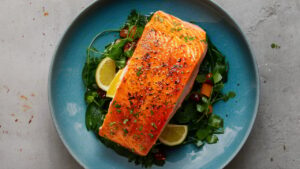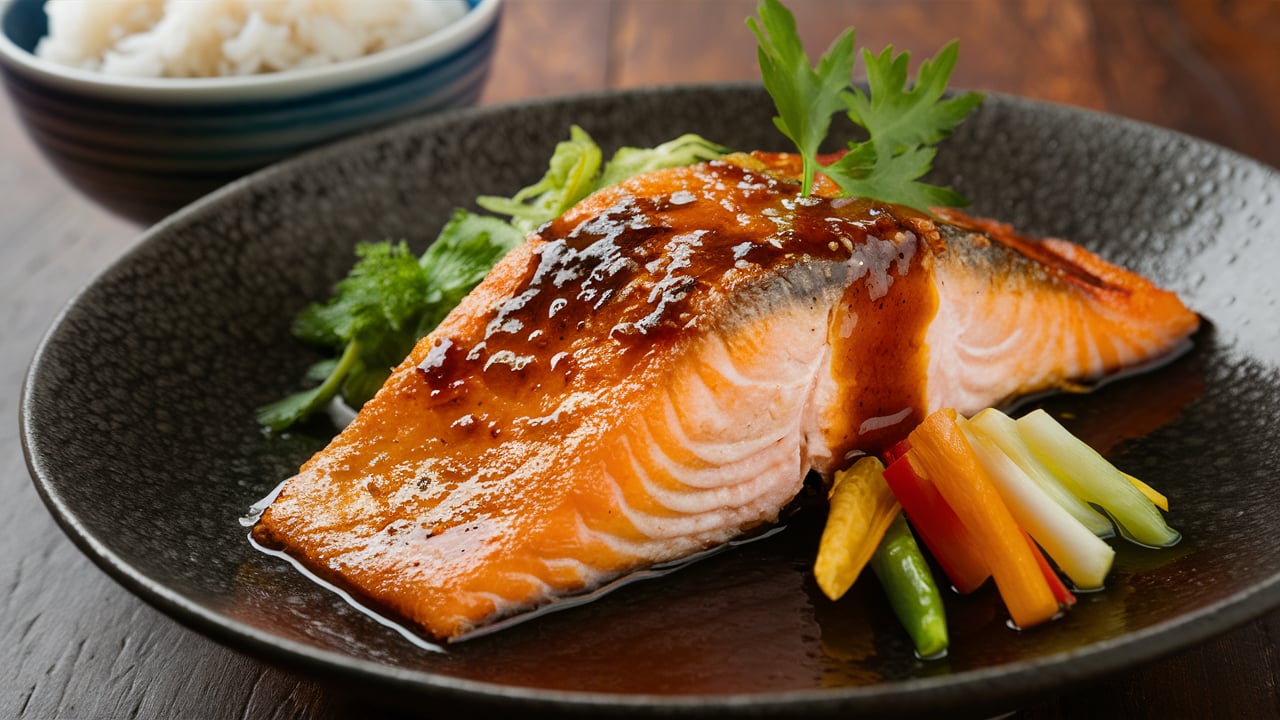Miso-glazed salmon is a delicious, savory dish that combines the rich flavors of miso with the tender, flaky texture of salmon. This popular dish hails from Japan, where miso is a fundamental ingredient in the cuisine. The sweet and savory glaze enhances the natural richness of the salmon, creating a balanced dish that’s satisfying yet healthy.
Whether you’re a seasoned chef or just beginning your culinary journey, miso-glazed salmon is a dish worth mastering. It’s quick to prepare, yet it delivers a complex depth of flavor that will impress even the most discerning of taste buds. In this guide, you’ll find everything you need to know—from ingredients to preparation tips, and even the best pairings to elevate your dining experience.
What Is Miso-Glazed Salmon Made Of?
Miso-glazed salmon is a simple yet flavorful dish made with a handful of high-quality ingredients. Each component plays an essential role in creating the rich, umami-packed glaze that coats the salmon. So, let’s break down what goes into this delectable dish:
Key Ingredients
- Salmon Fillets: The star of the dish. Fresh, high-quality salmon fillets are essential. Wild-caught salmon is often recommended for its richer flavor and firmer texture. Look for fillets with bright, pinkish-red flesh and no brown spots.
- Miso Paste: The key ingredient in the glaze. Miso is a traditional Japanese seasoning made from fermented soybeans. There are different types of miso, with white miso (shiro miso) being the most commonly used in this dish due to its milder and slightly sweeter taste. However, you can experiment with red miso (aka miso) for a more robust flavor.
- Mirin: A sweet Japanese rice wine that adds a subtle sweetness and balances the saltiness of the miso. If you don’t have mirin on hand, you can substitute it with a mixture of rice vinegar and sugar.
- Soy Sauce: A salty, umami-rich sauce that deepens the flavor of the glaze. Low-sodium soy sauce is often preferred to prevent the dish from becoming overly salty.
- Brown Sugar or Honey: This adds a touch of sweetness to the glaze, complementing the savory notes of the miso and soy sauce. Honey provides a slightly different flavor profile, with a floral sweetness that can enhance the dish.
- Ginger: Freshly grated ginger adds a zesty, spicy kick to the glaze, balancing the sweetness and enhancing the overall flavor complexity.
- Garlic: Minced garlic infuses the glaze with an aromatic depth, enriching the dish with its bold, savory flavor.
- Sesame Oil: A small amount of toasted sesame oil adds a nutty flavor that complements the miso and salmon. It also adds richness and a silky texture to the glaze.
These ingredients come together harmoniously to create a glaze that’s both savory and sweet, with a rich depth of flavor that elevates the natural taste of the salmon. Now that we understand the ingredients, let’s dive into the cooking process.
Step-by-Step Guide to Making Miso-Glazed Salmon
Ingredients:
- 4 salmon fillets (about 6 oz each)
- 3 tablespoons white miso paste
- 2 tablespoons mirin
- 1 tablespoon soy sauce (low sodium)
- 1 tablespoon brown sugar or honey
- 1 teaspoon freshly grated ginger
- 1 clove garlic, minced
- 1 teaspoon toasted sesame oil
- Sesame seeds and chopped green onions for garnish (optional)
1. Prepare the Glaze
To start, let’s make the miso glaze. In a small mixing bowl, whisk together the miso paste, mirin, soy sauce, brown sugar (or honey), ginger, garlic, and sesame oil. The result should be a smooth, thick glaze that’s packed with flavor. It’s important to taste the mixture at this stage to ensure the balance of flavors; the glaze should be both savory and slightly sweet, with a hint of spice from the ginger and garlic.
2. Marinate the Salmon
Next, place the salmon fillets in a shallow dish or resealable plastic bag. Pour half of the miso glaze over the salmon, making sure that each fillet is evenly coated. Allow the salmon to marinate for at least 30 minutes in the refrigerator. During this time, the flavors will penetrate the fish, making it more flavorful and tender.
3. Preheat the Oven
While the salmon is marinating, preheat your oven to 400°F (200°C). Line a baking sheet with parchment paper or aluminum foil for easy cleanup. If you have a broiler, you can also preheat that for the final step to achieve a beautifully caramelized finish on the glaze.
4. Bake the Salmon

Once the salmon has marinated, remove it from the marinade and place the fillets skin-side down on the prepared baking sheet. Bake the salmon for about 12-15 minutes, depending on the thickness of your fillets. The salmon is done when it flakes easily with a fork and the internal temperature reaches 145°F (63°C).
5. Broil for a Glaze Finish
To give the miso glaze a final touch of caramelization, switch your oven to broil during the last 2-3 minutes of baking. However, keep a close eye on the salmon to prevent burning. This broiling step adds a lovely golden color and intensifies the flavors of the glaze.
6. Garnish and Serve
Finally, remove the salmon from the oven and let it rest for a minute before serving. Garnish with sesame seeds and chopped green onions to add texture and flavor. Serve your miso-glazed salmon with your favorite sides, and enjoy the delicious results of your effort!
Pairings: What Goes Well with Miso-Glazed Salmon?
Miso-glazed salmon pairs beautifully with a variety of side dishes and beverages. In fact, the right pairing can elevate the meal even further. Let’s explore a few options that complement the rich flavors of the dish.
Best Side Dishes for Miso-Glazed Salmon
- Steamed Jasmine or Brown Rice: A classic accompaniment, rice helps to balance the rich flavors of the salmon. Brown rice adds a nutty, chewy texture, while jasmine rice provides a light, fragrant contrast.
- Roasted Vegetables: Consider roasting vegetables like asparagus, broccoli, or Brussels sprouts with a drizzle of olive oil and a sprinkle of sea salt. The roasted flavors complement the richness of the salmon while adding a crunchy texture.
- Sautéed Greens: Spinach, bok choy, or kale sautéed with garlic and a touch of sesame oil make a healthy, vibrant side dish. The slight bitterness of the greens balances the sweetness of the glaze.
- Asian-Inspired Slaw: A crunchy slaw made with cabbage, carrots, and a tangy sesame dressing adds freshness and texture to the meal.
Wine and Beverage Pairings
- Sake: A traditional Japanese rice wine, sake is a natural pairing for miso-glazed salmon. Opt for a slightly sweet or fruity sake to complement the savory and sweet glaze.
- Chardonnay: A lightly oaked Chardonnay pairs well with the rich flavors of the salmon, offering a balance of acidity and buttery texture.
- Riesling: A dry or off-dry Riesling works beautifully with the dish, as its sweetness and acidity cut through the richness of the salmon and complement the glaze.
- Green Tea: For a non-alcoholic option, a cup of green tea provides a refreshing contrast to the bold flavors of the miso glaze, with its slightly bitter and earthy notes.
By thoughtfully choosing your sides and beverages, you can create a complete dining experience that highlights the flavors of the miso-glazed salmon.
Health Benefits of Miso-Glazed Salmon
Miso-glazed salmon is not just delicious; it’s also packed with nutritional benefits. Including this dish in your diet can contribute to overall health, thanks to its nutrient-dense ingredients.
Nutritional Value of Key Ingredients
- Salmon: Salmon is rich in omega-3 fatty acids, which are essential for heart health. Omega-3s help reduce inflammation, lower blood pressure, and may even reduce the risk of heart disease. Furthermore, salmon is an excellent source of high-quality protein, vitamins B12 and D, and selenium, all of which are important for overall health and well-being.
- Miso Paste: Miso is a fermented food, which means it contains probiotics—beneficial bacteria that support gut health. Moreover, miso is a good source of essential minerals like zinc, manganese, and copper. It’s also relatively low in calories, making it a healthy addition to your meals when used in moderation.
- Ginger and Garlic: Both ginger and garlic have powerful anti-inflammatory and antioxidant properties. Ginger is known for aiding digestion and reducing nausea, while garlic supports immune function and heart health. Incorporating these ingredients into your meals not only enhances flavor but also boosts nutrition.
- Sesame Oil: Toasted sesame oil contains healthy fats, particularly polyunsaturated and monounsaturated fats, which can help improve cholesterol levels. Additionally, it adds a unique flavor to dishes, allowing you to use it sparingly for maximum impact.
Frequently Asked Questions (FAQs)
1. Can I use a different type of fish for this recipe?
Yes, while salmon is the traditional choice, you can substitute it with other types of fish such as cod, halibut, or even tilapia. The key is to choose a fish that can hold up to the bold flavors of the miso glaze. Just be sure to adjust cooking times accordingly, as leaner fish may cook faster than salmon.
2. Can I make this recipe in advance?
Certainly! You can prepare the miso glaze and marinate the salmon in advance. In fact, you can marinate the fish for up to 24 hours in the refrigerator. However, for the best texture, it’s recommended to cook the salmon just before serving. If you need to reheat leftovers, do so gently to avoid drying out the fish.
3. Is there a gluten-free option for miso-glazed salmon?
Yes, to make this recipe gluten-free, substitute the soy sauce with tamari, a gluten-free soy sauce alternative. Make sure to check the label on your miso paste as well, as some miso products may contain barley or wheat. Opt for a gluten-free miso paste to ensure the dish is safe for those with gluten sensitivities or celiac disease.
4. Can I grill the salmon instead of baking it?
Absolutely! Grilling is a great alternative to baking. Simply preheat your grill to medium-high heat, and oil the grates to prevent sticking. Grill the salmon skin-side down for about 4-5 minutes, then flip and cook for another 3-4 minutes, or until the salmon flakes easily. Be sure to brush on extra glaze during grilling for maximum flavor.
5. How can I store and reheat leftovers?
Store leftover miso-glazed salmon in an airtight container in the refrigerator for up to 3 days. To reheat, place the salmon in a preheated oven at 300°F (150°C) for 10-12 minutes, or until warmed through. Alternatively, you can gently reheat it in a skillet over medium-low heat. Avoid microwaving, as it can dry out the fish and diminish the flavor.
Conclusion: Why Miso-Glazed Salmon Is Worth the Effort
Miso-glazed salmon is a versatile and flavorful dish that brings the best of Japanese cuisine to your table. With its rich combination of savory, sweet, and umami flavors, it’s a meal that’s sure to impress. Not only is it delicious, but it’s also packed with nutrients that contribute to a healthy, balanced diet.
This dish is perfect for a quick weeknight dinner or a special occasion when you want to showcase your culinary skills. By following this guide, you’ll be able to create a restaurant-quality meal at home. The best part? The recipe is customizable, allowing you to experiment with different types of miso, fish, and side dishes.
Whether you’re new to cooking or an experienced chef, mastering miso-glazed salmon will add a new, flavorful dish to your repertoire. Enjoy the journey, and savor every bite!

